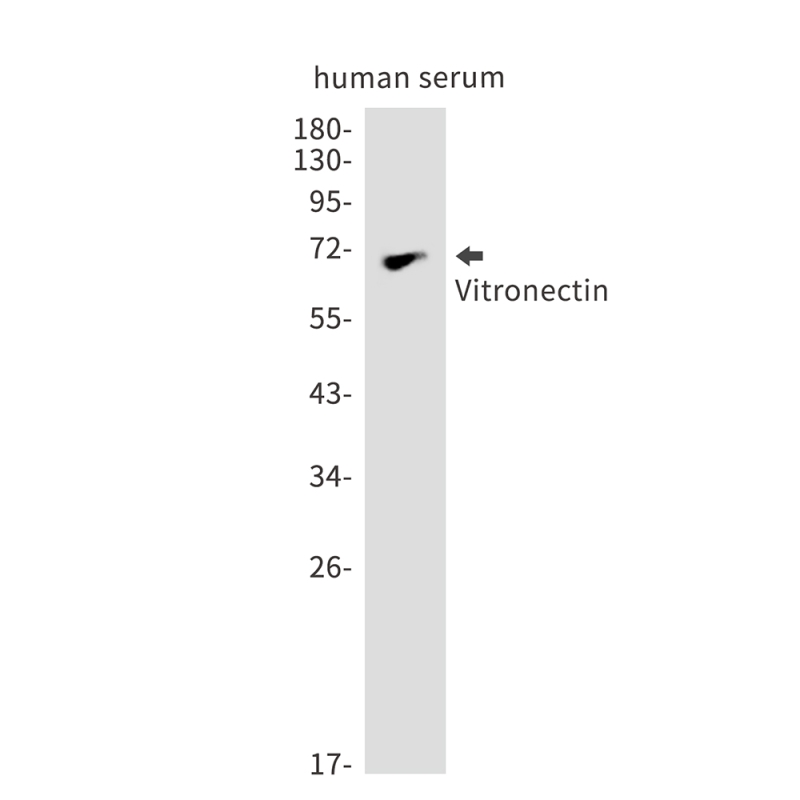
| WB | 1/500-1/1000 | Human,Mouse,Rat |
| IF | 咨询技术 | Human,Mouse,Rat |
| IHC | 1/50-1/100 | Human,Mouse,Rat |
| ICC | 1/50-1/200 | Human,Mouse,Rat |
| FCM | 咨询技术 | Human,Mouse,Rat |
| Elisa | 咨询技术 | Human,Mouse,Rat |
| Aliases | VTN; Vitronectin; VN; S-protein; Serum-spreading factor; V75 |
| Entrez GeneID | 7448 |
| WB Predicted band size | Calculated MW: 54 kDa; Observed MW: 70 kDa |
| Host/Isotype | Rabbit IgG |
| Antibody Type | Primary antibody |
| Storage | Store at 4°C short term. Aliquot and store at -20°C long term. Avoid freeze/thaw cycles. |
| Species Reactivity | Human |
| Immunogen | A synthetic peptide of human Vitronectin |
| Formulation | Purified antibody in TBS with 0.05% sodium azide,0.05%BSA and 50% glycerol. |
+ +
以下是3篇关于Vitronectin抗体的参考文献及其摘要概括:
1. **文献名称**: *"Monoclonal antibodies to human vitronectin: characterization and cross-reactivity with osteonectin"*
**作者**: Preissner KT, et al.
**摘要**: 该研究报道了针对人Vitronectin的单克隆抗体的开发,分析了其特异性及与细胞外基质蛋白Osteonectin的交叉反应性,揭示了两种蛋白在细胞黏附和伤口愈合中的潜在协同作用。
2. **文献名称**: *"Vitronectin antibodies promote apoptosis of endothelial cells via cell surface protein clustering"*
**作者**: Felding-Habermann B, et al.
**摘要**: 研究发现,特定抗Vitronectin抗体可通过诱导内皮细胞表面蛋白聚集激活caspase通路,导致细胞凋亡,提示Vitronectin在血管稳态中的关键调控作用。
3. **文献名称**: *"Targeting vitronectin in breast cancer metastasis using a novel neutralizing antibody"*
**作者**: Khan T, et al.
**摘要**: 研究开发了一种中和性Vitronectin抗体,证明其可阻断肿瘤细胞与血浆Vitronectin的结合,抑制乳腺癌小鼠模型中肺转移,为抗转移治疗提供新策略。
*注:若需获取全文,可通过PubMed/DOI号检索,或联系作者索取。*
Vitronectin antibodies are essential tools for studying vitronectin (VN), a multifunctional glycoprotein found in blood plasma and the extracellular matrix (ECM). Vitronectin plays critical roles in cell adhesion, migration, and survival by interacting with integrins (e.g., αvβ3. αvβ5) via its RGD motif. It also regulates coagulation, fibrinolysis, and complement activation by binding heparin, plasminogen activator inhibitor-1 (PAI-1), and other ligands. Structurally, VN exists as a 75-kDa single-chain form or a 65/10-kDa two-chain variant, with conformational flexibility influencing its functional diversity.
Antibodies targeting vitronectin are widely used in research to detect, quantify, or modulate its activity. Monoclonal antibodies offer high specificity for distinct epitopes, while polyclonal antibodies detect multiple regions, enhancing sensitivity in techniques like Western blotting, immunohistochemistry (IHC), and ELISA. Function-blocking antibodies are employed to disrupt VN-integrin interactions, aiding studies on cell-ECM dynamics, angiogenesis, or tumor metastasis. Conversely, stabilizing antibodies help explore VN’s role in maintaining pluripotency in stem cell cultures.
VN dysregulation is linked to pathologies like thrombosis, fibrosis, and cancer. Antibodies enable biomarker analysis in clinical samples, revealing VN’s overexpression in tumors or its altered forms in inflammatory diseases. Researchers must select antibodies based on application needs, species reactivity, and epitope compatibility. Validated antibodies are crucial for elucidating VN’s dual roles in tissue homeostasis and disease progression.
×